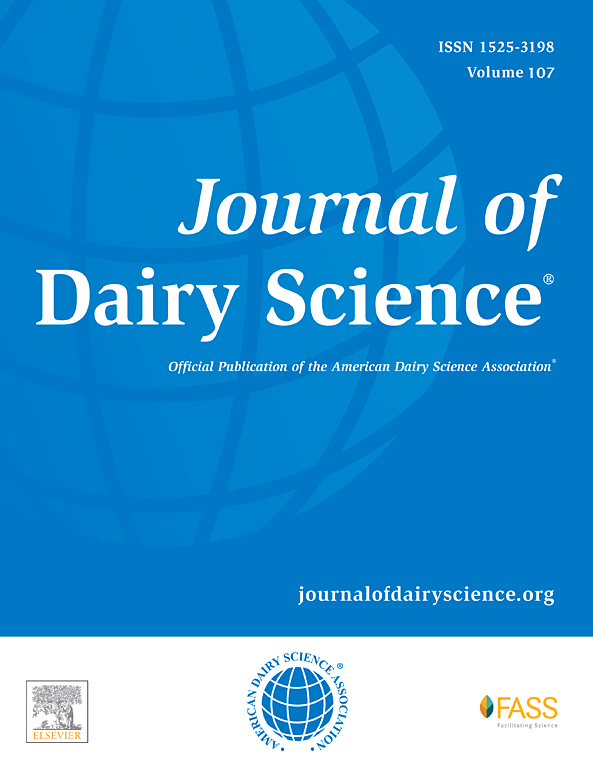酸性乳清浓缩蛋白对发酵骆驼乳中生物可及组分的流变学特性、抗氧化能力和生物活性的影响。
IF 4.4
1区 农林科学
Q1 AGRICULTURE, DAIRY & ANIMAL SCIENCE
引用次数: 0
摘要
骆驼乳酸奶具有独特的物理化学性质,不同于其他种类的牛奶,因此骆驼乳酸奶的生产具有挑战性。本研究旨在评价在骆驼乳中添加不同水平(0,3和6%)的乳清浓缩蛋白(WPC)对骆驼乳酸奶的质地、流变学特性、抗氧化能力和生物活性的影响,并与牛乳(BM)酸奶进行比较。在4°C下保存1和15 d后,对酸奶样品体外消化前后的这些特性进行了评估。结果表明,添加WPC,特别是添加6% (WPCA6)时,对酸奶的特性有显著影响。保水能力随WPC添加量的增加而增加,且高于BM酸奶。添加6% WPC的酸奶样品黏附力显著高于其他处理,1 d和15 d后黏附力分别为6.3和6.1 mJ。在不同剪切速率下,WPCA6的表观粘度也高于其他处理,表明酸奶更浓稠。与BM酸奶(22.9%)相比,骆驼乳酸奶的DPPH值更高,WPCA0、WPCA3和WPCA6的DPPH值分别为74.1、71.6和78.1%。体外消化后,酸奶样品的α-淀粉酶、α-葡萄糖苷酶和血管紧张素转换酶抑制活性均有所提高。主成分分析强调了WPCA6独特的生物活性特征,将其与其他酸奶处理区别开来,并突出了其优越的特性。本文章由计算机程序翻译,如有差异,请以英文原文为准。
Effect of acid whey protein concentrate on the rheological properties, antioxidant capacities, and biological activities of bioaccessible fractions in fermented camel milk
The production of set-type camel milk yogurt is challenging due to its unique physicochemical properties, which differ from those of other milk species. The present study aimed to evaluate the effects of camel milk supplementation with different levels (0% [WPCA0], 3% [WPCA3], and 6% [WPCA3]) of whey protein concentrate (WPC) on the texture, rheological properties, antioxidant capacity, and biological activity of camel milk yogurt compared with bovine milk (BM) yogurt. These characteristics were evaluated before and after in vitro digestion of yogurt samples after 1 and 15 d of storage at 4°C. The results show that using WPC, particularly at 6% (WPCA6), significantly affected the characteristics of yogurt. The water-holding capacity increased by increasing the level of WPC and showed higher values than BM yogurt. Furthermore, the adhesiveness in yogurt samples containing 6% of WPC was significantly higher than other treatments, representing 6.3 and 6.1 mJ after 1 and 15 d, respectively. The apparent viscosity of WPCA6 was also higher than other yogurt treatments at different shear rates throughout storage, indicating a thicker and more viscous yogurt. Camel milk yogurt showed higher 2,2-diphenyl-1-picrylhydrazyl values, representing 74.1%, 71.6%, and 78.1% for WPCA0, WPCA3, and WPCA6, respectively, compared with BM yogurt (22.9%). The biological activities, including α-amylase, α-glucosidase, and angiotensin-converting enzyme inhibition, increased after in vitro digestion of yogurt samples. Principal component analysis underscored the distinct bioactive profile of WPCA6, distinguishing it from other yogurt treatments and highlighting its superior properties.
求助全文
通过发布文献求助,成功后即可免费获取论文全文。
去求助
来源期刊

Journal of Dairy Science
农林科学-奶制品与动物科学
CiteScore
7.90
自引率
17.10%
发文量
784
审稿时长
4.2 months
期刊介绍:
The official journal of the American Dairy Science Association®, Journal of Dairy Science® (JDS) is the leading peer-reviewed general dairy research journal in the world. JDS readers represent education, industry, and government agencies in more than 70 countries with interests in biochemistry, breeding, economics, engineering, environment, food science, genetics, microbiology, nutrition, pathology, physiology, processing, public health, quality assurance, and sanitation.
 求助内容:
求助内容: 应助结果提醒方式:
应助结果提醒方式:


